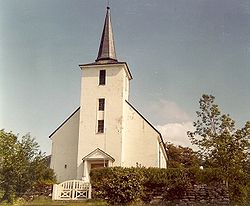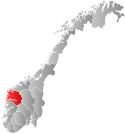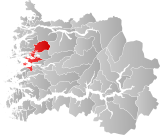Bru is a former municipality in the old Sogn og Fjordane county, Norway. The 382-square-kilometre (147 sq mi) municipality existed from 1923 until 1964 and it included several islands including Svanøya, Askrova, and Stavøya as well as parts of the mainland including the Solheimsdalen valley, east of the village of Norddalsfjord. It is now part of the present-day Kinn Municipality which is in Vestland county in the traditional district of Sunnfjord. The administrative center of Bru was the village of Stavang.[2]
Bru Municipality
Bru herad | |
|---|---|
 Stavang Church in Bru | |
 Sogn og Fjordane within Norway | |
 Bru within Sogn og Fjordane | |
| Coordinates: 61°32′05″N 05°10′56″E / 61.53472°N 5.18222°E | |
| Country | Norway |
| County | Sogn og Fjordane |
| District | Sunnfjord |
| Established | 1 Jan 1923 |
| • Preceded by | Kinn Municipality |
| Disestablished | 1 Jan 1964 |
| • Succeeded by | Flora Municipality |
| Administrative centre | Stavang |
| Area (upon dissolution) | |
• Total | 382 km2 (147 sq mi) |
| Population (1964) | |
• Total | 1,247 |
| • Density | 3.3/km2 (8.5/sq mi) |
| Time zone | UTC+01:00 (CET) |
| • Summer (DST) | UTC+02:00 (CEST) |
| ISO 3166 code | NO-1436[1] |
History
editThe parish of Bru was established as a municipality on 1 January 1923 when the large municipality of Kinn was divided into three: Kinn (population: 2,508) in the west, Bru (population: 1,560) in the centre, and Eikefjord (population: 929) in the east.[3]
During the 1960s, there were many municipal mergers across Norway due to the work of the Schei Committee. On 1 January 1964, Bru municipality ceased to exist and its lands were divided.[3]
- All of Bru located north of the Førdefjorden (population: 1,155) was merged with the town of Florø (population: 2,040), Kinn Municipality (population: 3,567), Eikefjord Municipality (population: 919), the Husefest and Breivik areas of Bremanger Municipality (population: 9), and the Steindal area of Vevring Municipality (population: 25) were combined to form the new municipality of Flora.
- All of Bru located south of the Førdefjorden (population: 92) was merged with Askvoll Municipality (population: 3,086) and the parts of Vevring Municipality located south of the Førdefjorden (population: 407).
Name
editThe municipality (originally the parish) is named after the island Brulandet, now called Svanøya, (Old Norse: Brúa) since the first Bru Church was built on the island (the church site was mved off the island to the mainland village of Stavang in 1872). The old name of the island is identical to the plural genitive case of the word brú which means "bridge".[4]
Government
editDuring its existence, this municipality was governed by a municipal council of directly elected representatives. The mayor was indirectly elected by a vote of the municipal council.[5]
Mayors
edit- 1923-1925: Bjarne Svanøe
- 1925-1926: Nikolai Haave
- 1926–1937: Per Hjertenes
- 1938–1940: Per Straumsnes
- 1945–1945: Per Straumsnes
- 1946-1947: Per Hjertenes
- 1948-1955: Tor Grønnevik
- 1956–1964: Anton Holm
Municipal council
editThe municipal council (Heradsstyre) of Bru was made up of 17 representatives that were elected to four year terms. The party breakdown of the final municipal council was as follows:
| Party name (in Nynorsk) | Number of representatives | |
|---|---|---|
| Labour Party (Arbeidarpartiet) | 5 | |
| Liberal Party (Venstre) | 6 | |
| Joint List(s) of Non-Socialist Parties (Borgarlege Felleslister) | 4 | |
| Local List(s) (Lokale lister) | 2 | |
| Total number of members: | 17 | |
| Party name (in Nynorsk) | Number of representatives | |
|---|---|---|
| Labour Party (Arbeidarpartiet) | 6 | |
| Joint List(s) of Non-Socialist Parties (Borgarlege Felleslister) | 7 | |
| Local List(s) (Lokale lister) | 4 | |
| Total number of members: | 17 | |
| Party name (in Nynorsk) | Number of representatives | |
|---|---|---|
| Labour Party (Arbeidarpartiet) | 5 | |
| Farmers' Party (Bondepartiet) | 1 | |
| Liberal Party (Venstre) | 3 | |
| Joint List(s) of Non-Socialist Parties (Borgarlege Felleslister) | 2 | |
| Local List(s) (Lokale lister) | 5 | |
| Total number of members: | 16 | |
| Party name (in Nynorsk) | Number of representatives | |
|---|---|---|
| Labour Party (Arbeidarpartiet) | 8 | |
| Liberal Party (Venstre) | 3 | |
| Joint List(s) of Non-Socialist Parties (Borgarlege Felleslister) | 5 | |
| Total number of members: | 16 | |
| Party name (in Nynorsk) | Number of representatives | |
|---|---|---|
| Labour Party (Arbeidarpartiet) | 7 | |
| Local List(s) (Lokale lister) | 9 | |
| Total number of members: | 16 | |
| Party name (in Nynorsk) | Number of representatives | |
|---|---|---|
| Labour Party (Arbeidarpartiet) | 6 | |
| Liberal Party (Venstre) | 5 | |
| Joint List(s) of Non-Socialist Parties (Borgarlege Felleslister) | 5 | |
| Total number of members: | 16 | |
| Note: Due to the German occupation of Norway during World War II, no elections were held for new municipal councils until after the war ended in 1945. | ||
See also
editReferences
edit- ^ Bolstad, Erik; Thorsnæs, Geir, eds. (9 January 2024). "Kommunenummer". Store norske leksikon (in Norwegian). Foreningen Store norske leksikon.
- ^ Thorsnæs, Geir, ed. (27 September 2019). "Bru - sogn". Store norske leksikon (in Norwegian). Kunnskapsforlaget. Retrieved 28 September 2019.
- ^ a b Jukvam, Dag (1999). Historisk oversikt over endringer i kommune- og fylkesinndelingen (PDF) (in Norwegian). Statistisk sentralbyrå. ISBN 9788253746845.
- ^ Rygh, Oluf (1919). Norske gaardnavne: Nordre Bergenhus amt (in Norwegian) (12 ed.). Kristiania, Norge: W. C. Fabritius & sønners bogtrikkeri. pp. 364 and 371.
- ^ Hansen, Tore; Vabo, Signy Irene, eds. (20 September 2022). "kommunestyre". Store norske leksikon (in Norwegian). Kunnskapsforlaget. Retrieved 1 January 2023.
- ^ "Ordførarar i Flora". NRK Fylkesliksikon (in Norwegian). 25 March 2004. Retrieved 29 May 2023.
- ^ "Kommunevalgene og Ordførervalgene 1959" (PDF) (in Norwegian). Oslo: Statistisk sentralbyrå. 1960. Retrieved 16 February 2020.
- ^ "Kommunevalgene og Ordførervalgene 1955" (PDF) (in Norwegian). Oslo: Statistisk sentralbyrå. 1957. Retrieved 16 February 2020.
- ^ "Kommunevalgene og Ordførervalgene 1951" (PDF) (in Norwegian). Oslo: Statistisk sentralbyrå. 1952. Retrieved 16 February 2020.
- ^ "Kommunevalgene og Ordførervalgene 1947" (PDF) (in Norwegian). Oslo: Statistisk sentralbyrå. 1948. Retrieved 16 February 2020.
- ^ "Kommunevalgene og Ordførervalgene 1945" (PDF) (in Norwegian). Oslo: Statistisk sentralbyrå. 1947. Retrieved 16 February 2020.
- ^ "Kommunevalgene og Ordførervalgene 1937" (PDF) (in Norwegian). Oslo: Statistisk sentralbyrå. 1938. Retrieved 11 May 2020.
External links
edit- Sogn og Fjordane travel guide from Wikivoyage